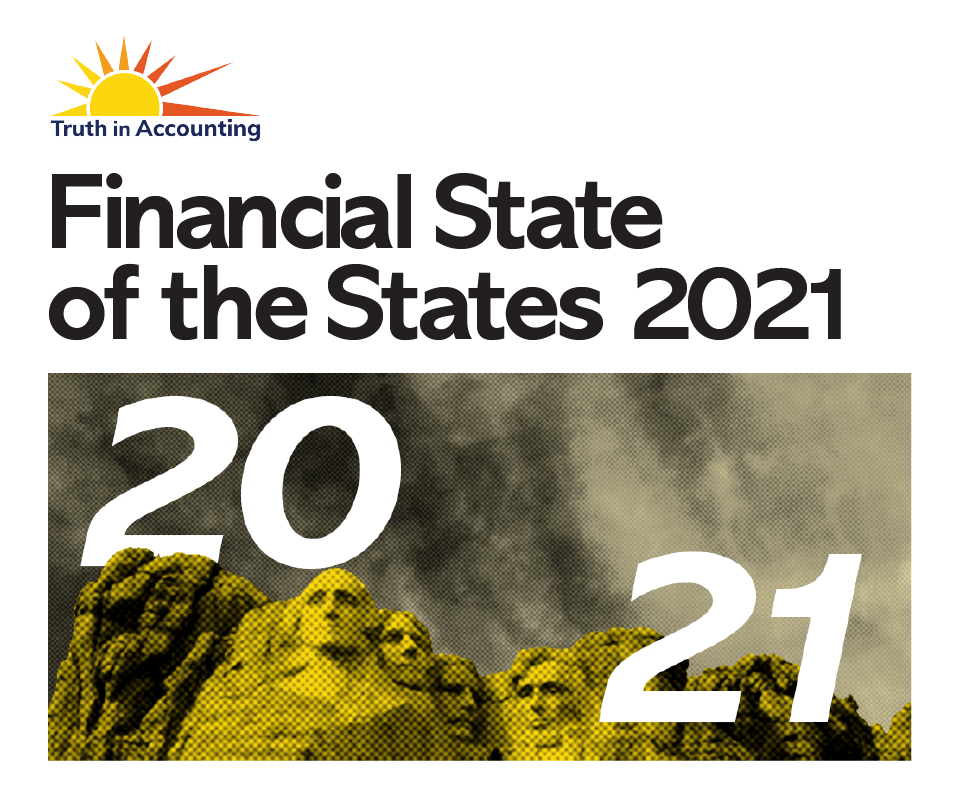
**To read the full report, please click here to download the PDF**
Financial State of the States 2021
From Truth in Accounting, September 28, 2021
Truth in Accounting has released its twelfth annual Financial State of the States report, a nationwide analysis of the most recent state government financial information. This comprehensive analysis surveys the fiscal health of the 50 states during the beginning of the COVID-19 pandemic.
Despite receiving federal assistance from the CARES Act and other COVID-19 related grants, the majority of states’ finances worsened. Total debt among the 50 states amounted to $1.5 trillion at the end of the fiscal year 2020.
Bottom Five Sinkhole States:
(46) HAWAII needed $18 billion more than it had to pay its bills, or $37,000 per taxpayer, at the end of fiscal year 2020. More than half of Hawaii’s debt comes from unfunded pension benefits, which totaled $10.4 billion. Hawaii remained in the bottom five Sinkhole States for the third year in a row….
Hawaii’s Financial Condition Worsened Despite Federal Funds
Financial State of Hawaii, September, 2021
Despite receiving support from COVID relief grants and other federal programs, Hawaii’s overall financial condition worsened during the onset of the pandemic. Based upon the state’s fiscal year 2020 audited financial report, Hawaii had a Taxpayer Burden™ of $37,000, earning it an “F” grade from Truth in Accounting.
Hawaii’s elected officials have repeatedly made financial decisions that left the state with a debt burden of $18 billion. That burden came to $37,000 for every state taxpayer. Hawaii’s financial problems stem mostly from unfunded retirement obligations that accumulated over the years. The state had only set aside 53 cents for every dollar of promised pension benefits and 21 cents for every dollar of promised retiree health care benefits.
Hawaii did not have enough money set aside to weather the pandemic and the state has been in dire fiscal shape for years. Like all other states, Hawaii received federal assistance from the CARES Act and other COVID-19 related grants which came with stipulations on how the money could be spent. The state has not been properly funding its pension and retiree health care promises for years which has led to its financial condition continuing to deteriorate.
The data included in this report is derived from the state of Hawaii’s 2020 audited Annual Comprehensive Financial Report and retirement plans’ reports. To compare states’ financial information go to Data-Z.org.
Hawaii’s Financial Breakdown
Fast Facts
- Hawaii had $6.5 billion available to pay $24.5 billion worth of bills.
- The outcome was a $18 billion shortfall, which breaks down to a burden of $37,000 per taxpayer.
- Hawaii’s overall financial condition worsened by 11 percent during the onset of the pandemic mostly because pension plan liabilities increased faster than investment income.
THE STATE’S BILLS EXCEEDED ITS ASSETS
| Total assets |
$29,882,901,000 |
| Minus: Capital assets |
($18,146,796,000) |
| Restricted assets |
($5,229,969,000) |
| Assets available to pay bills |
$6,506,136,000 |
| Minus: Total bills |
($24,458,251,000) |
| Money available (needed) to pay bills |
($17,952,115,000) |
| Each taxpayer’s share of this debt |
($37,000) |
BILLS THE STATE ACCUMULATED
| Bonds |
$10,551,295,000 |
| Other liabilities |
$4,298,787,000 |
| Minus: Debt related to capital assets |
($10,248,820,000) |
| Unfunded pension benefits |
$10,436,241,000 |
| Unfunded retiree health care benefits |
$9,420,748,000 |
| Total bills |
$24,458,251,000 |
Grade F
Bottom line: Hawaii would need $37,000 from each of its taxpayers to pay all of its bills, so it received an “F” for its finances. According to Truth in Accounting’s grading scale, any government with a Taxpayer Burden greater than $20,000 receives an “F” grade.
read … Full Report
JTN: Seven of the 10 states in worst financial condition are run by Democrats